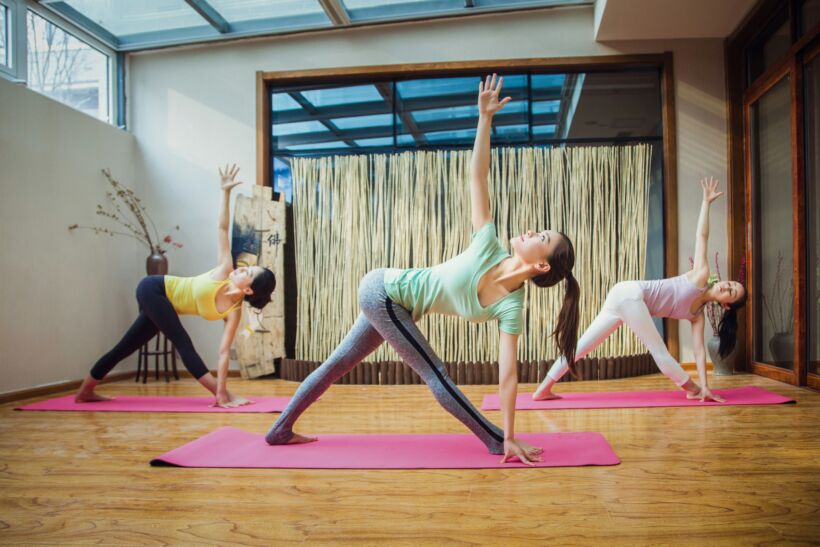Have you ever wondered how deep stretching can truly enhance your joint flexibility? Are you looking for effective exercises to improve your range of motion and overall joint health? Brace yourself, because in this article, we will unravel the profound impact of deep stretching on joint flexibility and reveal the hidden benefits that will leave you astounded.
Deep stretching goes beyond just reaching for your toes or performing simple stretches. It involves targeted exercises that have the power to unlock your joints and unleash their full potential. But what exactly are the benefits? What exercises should you incorporate into your routine? Prepare to be amazed, as we delve into the wonderful world of deep stretching and its transformative effects on your joints.
Understanding Joint Flexibility and its Importance
Before diving into the impact of deep stretching, it’s crucial to understand what joint flexibility is and why it is important for overall health. Joint flexibility refers to the ability of a joint to move through its full range of motion without pain or discomfort. It is influenced by various factors such as muscle length, joint structure, and connective tissue elasticity.
Joint flexibility plays a vital role in maintaining mobility and performing everyday activities with ease. Whether it’s bending, lifting, or reaching, flexible joints allow you to move freely and efficiently. They also contribute to proper posture, balance, and coordination.
Without adequate joint flexibility, your movements can become restricted, leading to stiffness, muscle imbalances, and increased risk of injury. Lack of flexibility can also impact sports performance and limit your ability to engage in physical activities you enjoy.
The Importance of Joint Mobility
Joint mobility, closely related to joint flexibility, refers to the ability of a joint to move freely through its intended range of motion. It goes beyond simply being flexible and encompasses the overall health and functionality of the joint.
When you have good joint mobility, you can perform basic movements like squatting, lunging, and twisting without any restrictions. This allows for optimal biomechanics and efficient muscle recruitment during exercise or daily tasks.
Joint mobility also plays a crucial role in injury prevention. Adequate mobility ensures that the stresses placed on your joints are distributed evenly, reducing the risk of overloading and subsequent damage. It also helps maintain joint health by promoting proper lubrication and nourishment of the joint structures.
Attaining and maintaining joint mobility and flexibility requires regular practice and a comprehensive approach, which includes deep stretching as a key component.
Deep Stretching and Joint Flexibility
Deep stretching is a fundamental practice that helps enhance joint flexibility. It involves holding specific stretching positions for an extended period, allowing the targeted muscles and connective tissues to gradually lengthen and release tension.
When you engage in deep stretching consistently, it stimulates adaptations in the muscles, tendons, and ligaments surrounding the joint. These adaptations lead to increased flexibility and improved joint range of motion.
Deep stretching also promotes blood flow to the muscles and joints, delivering essential nutrients and oxygen. This increased circulation helps alleviate muscle soreness, reduces stiffness, and enhances tissue repair and recovery.
Additionally, deep stretching can help correct muscle imbalances, which can contribute to joint dysfunction and restricted flexibility. By stretching tight muscles and strengthening weak ones, you can restore balance and optimize joint function.
Overall, deep stretching is an essential practice for improving joint flexibility, joint mobility, and maintaining optimal joint health. By incorporating deep stretching exercises into your fitness routine, you can experience the benefits of increased flexibility and enhanced overall well-being.
How Deep Stretching Enhances Joint Flexibility
Deep stretching techniques play a crucial role in enhancing joint flexibility. By targeting specific muscle groups and promoting increased range of motion, deep stretching exercises effectively improve joint mobility. Let’s explore some effective deep stretching techniques that can help you improve your joint flexibility.
The Importance of Dynamic Stretching
Dynamic stretching is a form of deep stretching that involves active movements through a full range of motion. Unlike static stretching, which involves holding a stretch for a prolonged period, dynamic stretching helps to warm up the muscles and prepare them for movement.
Dynamic stretches, such as leg swings, arm circles, and walking lunges, not only increase blood flow to the muscles but also enhance joint lubrication and flexibility. By incorporating dynamic stretching into your warm-up routine, you can optimize your joint flexibility before engaging in physical activity.
Active Isolated Stretching
Active Isolated Stretching (AIS) is another effective deep stretching technique that focuses on stretching individual muscles while actively engaging the opposing muscle group. This technique involves holding a stretch for only 1-2 seconds, making it a gentle yet effective way to improve joint flexibility.
AIS targets specific muscle groups and helps to release tension and increase overall joint mobility. It is often used by athletes and physical therapists to enhance performance and prevent injuries.
Proprioceptive Neuromuscular Facilitation (PNF)
Proprioceptive Neuromuscular Facilitation (PNF) is a type of deep stretching that involves contracting and relaxing specific muscles to achieve a deeper stretch. PNF stretching techniques can significantly improve joint flexibility by targeting both the muscles and the nervous system.
One common PNF stretching technique is the contract-relax method. This involves contracting the muscle being stretched for about 5-10 seconds, then relaxing the muscle and deepening the stretch. By alternating between muscle contractions and stretches, PNF stretching helps to increase joint range of motion.
A Sample Deep Stretching Routine
Here is a sample deep stretching routine that incorporates the techniques mentioned above:
| Stretching Technique | Targeted Muscle Group |
|---|---|
| Leg Swings | Hip Flexors and Hamstrings |
| Arm Circles | Shoulders and Upper Back |
| Walking Lunges | Quadriceps and Hip Flexors |
| AIS Calf Stretch | Calf Muscles |
| PNF Hamstring Stretch | Hamstrings |
| PNF Shoulder Stretch | Shoulders and Chest |
Remember to always listen to your body and stretch within your comfort zone. Gradually increase the intensity and duration of your deep stretching routine over time to avoid strain or injury. Consult with a healthcare professional or certified trainer for personalized guidance and modifications if needed.
Benefits of Deep Stretching for Joint Health
Deep stretching offers numerous benefits for joint health. Regular deep stretching can naturally increase joint flexibility and contribute to overall joint health. By incorporating deep stretching exercises into your fitness routine, you can experience improved joint mobility and enhanced well-being.
One of the primary benefits of deep stretching is its ability to increase joint flexibility naturally. When you engage in deep stretching regularly, you stretch the muscles, tendons, and ligaments surrounding your joints. This helps to improve the range of motion in your joints, allowing for smoother and more fluid movements.
Stretching also helps to maintain and restore proper alignment of the joints, reducing the risk of joint stiffness and pain. By elongating and strengthening the muscles around your joints, deep stretching can alleviate tension and pressure on the joints, promoting better joint function and reducing the likelihood of injuries.
“Deep stretching exercises can improve joint flexibility and alleviate joint pain. By gently stretching the muscles and connective tissues surrounding the joints, deep stretching helps to release tension and increase blood flow, promoting joint health.”
In addition to increasing joint flexibility, deep stretching also improves blood circulation to the joints. This increased blood flow delivers essential nutrients and oxygen to the joint tissues, promoting their health and aiding in the repair of damaged tissues. Improved blood circulation also helps to remove toxins and waste products from the joints, further supporting their overall health and function.
Regular deep stretching for joint health can also have a positive impact on your overall well-being. It can help reduce stress and tension, improve posture, and enhance your balance and coordination. By incorporating deep stretching exercises into your daily routine, you can cultivate a healthier and more resilient body, allowing you to move with greater ease and comfort.
Benefits of Deep Stretching for Joint Health
| Benefits | Description |
|---|---|
| Improved joint flexibility | Deep stretching increases the range of motion in your joints, allowing for smoother and more fluid movements. |
| Relief from joint pain | Deep stretching helps alleviate tension and pressure on the joints, reducing the risk of joint pain and discomfort. |
| Better joint function | By maintaining proper alignment and strengthening the muscles surrounding the joints, deep stretching promotes better joint function. |
| Improved blood circulation | Deep stretching increases blood flow to the joints, delivering essential nutrients and oxygen for their health and repair. |
| Stress reduction | Engaging in deep stretching exercises can help reduce stress and tension throughout the body. |
| Improved posture, balance, and coordination | Regular deep stretching can improve posture and enhance balance and coordination. |
By understanding the benefits of deep stretching for joint health, you can make it an integral part of your fitness routine. Incorporate a variety of deep stretching techniques and exercises for different muscle groups to maximize the benefits and promote optimal joint flexibility and overall well-being.
Effective Deep Stretching Techniques for Joint Flexibility
To improve joint flexibility, it is crucial to incorporate effective deep stretching techniques into your fitness routine. These techniques specifically target the muscles and ligaments surrounding the joints, helping to increase range of motion and enhance overall flexibility. By regularly practicing these deep stretching exercises, you can experience improved joint mobility and reduce the risk of injuries.
1. Pigeon Pose
The Pigeon Pose is an excellent deep stretching technique that primarily targets the hip joints. Start by sitting on the floor with one leg extended behind you and the other leg bent and brought towards your chest. Lean forward, placing your hands on the floor in front of you, and lower your chest towards the ground. Hold this pose for 30 seconds to one minute, breathing deeply and relaxing into the stretch. Repeat on the other side.
2. Standing Forward Bend
The Standing Forward Bend is a simple yet effective deep stretching exercise that targets the hamstrings and lower back. Stand with your feet hip-width apart and slowly bend forward from the hips, reaching your hands towards the ground or grabbing onto your ankles. You should feel a stretch along the back of your legs and spine. Hold this pose for 30 seconds to one minute, keeping your knees slightly bent if necessary.
3. Child’s Pose
The Child’s Pose is a gentle deep stretch that targets the lower back and hips. Start by kneeling on the floor, then gradually bring your hips back, sitting them on your heels. Extend your arms forward, placing your forehead on the ground. Allow your spine to lengthen and relax, feeling the stretch in your lower back and hips. Hold this pose for 30 seconds to one minute, focusing on your breathing and releasing any tension.
4. Supine Spinal Twist
The Supine Spinal Twist is an effective deep stretching technique for improving mobility in the spine and hips. Lie on your back with your arms extended out to the sides, palms facing down. Bend one knee and slowly bring it across your body towards the opposite side, using your opposite hand to guide the knee. Keep both shoulders on the ground and gaze towards the opposite direction. Hold this stretch for 30 seconds to one minute, then repeat on the other side.
5. Downward Facing Dog
Downward Facing Dog is a classic yoga pose that targets the entire body, including the shoulders, hamstrings, calves, and ankles. Start on your hands and knees, then push your hips up and back, straightening your legs and forming an inverted V shape with your body. Press your hands into the floor and lengthen your spine, aiming to bring your heels towards the ground. Hold this pose for 30 seconds to one minute, focusing on deep, steady breaths.
Remember to always warm up before performing deep stretching exercises and listen to your body’s limits. Start slowly and gradually increase the intensity and duration of the stretches over time. Consistency is key when it comes to improving joint flexibility through deep stretching techniques.
By incorporating these effective deep stretching techniques into your fitness routine, you can enhance joint flexibility, reduce muscle tension, and promote overall joint health. Remember to consult with a healthcare professional or qualified fitness instructor before starting any new exercise program, especially if you have any pre-existing health conditions or concerns.
Deep Stretching Routines for Enhanced Joint Flexibility
Now that you have learned about the benefits of deep stretching for joint flexibility, it’s time to put that knowledge into action. In this section, we will outline comprehensive deep stretching routines that target multiple areas of the body. These routines, when practiced regularly, can greatly enhance joint flexibility and contribute to overall joint health.
Before starting any stretching routine, it’s important to warm up your muscles and joints with light cardiovascular activity, such as brisk walking or cycling, for at least 5 to 10 minutes. This will help prepare your body for the deep stretches that follow.
Full-Body Deep Stretching Routine
This routine focuses on stretching the major muscle groups throughout your body, promoting overall joint flexibility and mobility. Perform each stretch for 30-60 seconds and repeat the routine 2-3 times.
- Standing Forward Fold: Stand with your feet hip-width apart and slowly fold forward from your hips, reaching towards your toes. Let gravity pull you deeper into the stretch.
- Downward Facing Dog: Start in a push-up position, lift your hips up and back, and push your heels towards the ground. Feel the stretch in your calves, hamstrings, and shoulders.
- Child’s Pose: Kneel on the floor, touch your big toes together, and sit on your heels. Slowly lower your torso down and stretch your arms out in front of you.
- Pigeon Pose: Begin in a plank position, bring your right knee forward and place it behind your right wrist. Extend your left leg straight back and lower your torso down, feeling the stretch in your hip and glutes.
- Seated Forward Bend: Sit on the ground with your legs extended in front of you. Reach forward and try to touch your toes, keeping your back straight.
- Seated Spinal Twist: Sit on the ground with your legs extended. Bend your right knee and place your right foot outside your left knee. Twist your torso to the right, using your left arm as a lever for a deeper stretch.
Targeted Deep Stretching Routine
If you’re looking to improve flexibility in specific areas, this routine focuses on targeted stretches for key joints, such as shoulders, hips, and ankles. Perform each stretch for 30-60 seconds and repeat the routine 2-3 times.
- Shoulder Stretch: Stand tall and roll your shoulders back. Extend one arm across your chest and gently pull it towards your body with the opposite arm.
- Butterfly Stretch: Sit on the ground and bring the soles of your feet together. Gently press your knees towards the ground, feeling the stretch in your hips and groin.
- Quadriceps Stretch: Stand tall and lift one heel towards your glutes, grabbing your ankle with your hand. Gently pull your ankle towards your glutes, feeling the stretch in the front of your thigh.
- Standing Calf Stretch: Stand facing a wall and place your hands on the wall for support. Step one foot back and press your heel into the ground, stretching your calf muscle.
- Ankle Circles: Sit on the ground with your legs extended. Lift one foot off the ground and rotate your ankle clockwise, then counter-clockwise.
Remember to listen to your body and never push yourself beyond your limits. If you experience any pain or discomfort during a stretch, ease off and modify the position as needed. Consistency is key when it comes to deep stretching, so aim to incorporate these routines into your fitness regimen at least 2-3 times per week.

Precautions and Safety Measures for Deep Stretching
When incorporating deep stretching techniques into your joint flexibility exercises, it’s crucial to prioritize safety to avoid injuries and ensure a productive workout. Follow these important precautions and safety measures to maximize the benefits of deep stretching while minimizing the risk of harm:
- Warm-up: Before diving into deep stretches, always warm up your body with light cardiovascular exercises such as jogging or jumping rope. Warming up increases blood flow to your muscles, making them more flexible and less prone to injury.
- Start slow: If you’re new to deep stretching, start with gentle and basic stretches to allow your body to adjust gradually. Avoid pushing beyond your limits too quickly.
- Proper form: Maintain correct form and alignment during each stretch to target the intended muscles and avoid unnecessary strain. Poor form can lead to injuries and negate the benefits of deep stretching.
- Listen to your body: Pay attention to your body’s signals and adjust the intensity or duration of stretches accordingly. Pain or discomfort may indicate that you’re pushing too hard or performing the stretch incorrectly.
- Breathe and relax: Deep breathing promotes relaxation and helps release tension during stretching. Remember to inhale deeply and exhale slowly as you perform each stretch.
- Avoid bouncing: Do not use bouncing or jerking motions while stretching. Instead, perform each stretch in a smooth and controlled manner to prevent muscle strains or tears.
- Modify if needed: If you have any existing injuries or medical conditions, consult with a healthcare professional or a qualified fitness trainer to determine which stretches are safe and appropriate for you.
- Balance your routine: Don’t solely focus on deep stretching exercises. Include a well-rounded fitness routine that incorporates strength training, cardiovascular exercises, and other forms of exercise to support overall joint health.
Remember, deep stretching is a gradual process that requires patience and consistency. By following these precautions and safety measures, you can enjoy the benefits of deep stretching while minimizing the risk of injuries.
| Precaution | Safety Measure |
|---|---|
| Warm-up | Always perform a proper warm-up before deep stretching. |
| Start slow | Gradually increase the intensity of stretches over time. |
| Proper form | Maintain correct alignment and posture during each stretch. |
| Listen to your body | Pay attention to any pain or discomfort and adjust accordingly. |
| Breathe and relax | Take deep breaths and focus on relaxation during stretches. |
| Avoid bouncing | Avoid jerking or bouncing movements while stretching. |
| Modify if needed | Consult with a professional if you have any medical conditions or injuries. |
| Balance your routine | Incorporate a mix of exercises to support overall joint health. |
Expert Tips for Maximizing Joint Flexibility through Deep Stretching
Unlocking the full potential of your joint flexibility requires a strategic approach to deep stretching. To help you optimize your stretching routine and achieve maximum joint flexibility, we’ve gathered valuable tips and insights from experts in the field. Incorporate these expert recommendations into your practice to experience enhanced results.
1. Gradually Increase Intensity
Deep stretching should be approached gradually to avoid injury and promote long-term joint flexibility. Start with gentle stretches and gradually increase the intensity over time. This allows your muscles and joints to adjust and adapt, leading to improved flexibility and reduced risk of strain. Remember, patience and consistency are key.
2. Focus on Balanced Stretching
While targeting specific areas of your body is important, it’s equally crucial to maintain a balanced stretching routine. By incorporating stretches that target multiple muscle groups and joints, you can ensure overall joint flexibility and avoid muscle imbalances. Aim for a well-rounded stretching routine that covers different parts of your body.
3. Incorporate Dynamic Stretching
Dynamic stretching involves controlled movements that take joints and muscles through a full range of motion. Including dynamic stretches in your routine helps warm up your muscles and prepares them for deeper, static stretches. This can further enhance joint flexibility and improve overall performance.
4. Practice Mindful Breathing
Deep stretching is not just about physical movement but also about connecting with your body and mind. Incorporating deep breathing exercises during stretches can promote relaxation, reduce muscle tension, and improve your overall stretching experience. Take slow, deep breaths as you hold each stretch to enhance its effectiveness.
5. Listen to Your Body
Each individual is unique, and what works for one person may not work for another. It’s important to listen to your body and respect its limitations. Avoid forcing yourself into uncomfortable or painful positions, as this can lead to injury. Instead, focus on finding your personal edge and gradually pushing it over time.
“Deep stretching is a powerful tool for improving joint flexibility, but it requires mindful practice. Rome wasn’t built in a day, and neither is flexibility. Take your time, be consistent, and the results will come.”
– Dr. Jane Roberts, Physical Therapist
6. Incorporate Active Recovery
Active recovery exercises, such as light aerobic activity or gentle mobility exercises, can be beneficial for joint flexibility. Including active recovery sessions on rest days can help prevent stiffness and maintain the gains made through deep stretching. Aim for low-impact activities that promote blood flow and provide a gentle stretch to your muscles and joints.
7. Stay Hydrated
Hydration plays a vital role in maintaining joint health and flexibility. Proper hydration helps lubricate your joints and prevents stiffness. Make sure to drink an adequate amount of water throughout the day, especially before and after your deep stretching routine. This simple yet essential step can contribute to maximizing the benefits of your stretching practice.
| Expert Tips for Maximizing Joint Flexibility | |
|---|---|
| Gradually increase intensity | ✓ |
| Focus on balanced stretching | ✓ |
| Incorporate dynamic stretching | ✓ |
| Practice mindful breathing | ✓ |
| Listen to your body | ✓ |
| Incorporate active recovery | ✓ |
| Stay hydrated | ✓ |
By incorporating these expert tips into your deep stretching routine, you can optimize your joint flexibility and unlock a greater range of motion. Remember to always prioritize safety, listen to your body, and consult with a healthcare professional if you have any concerns.

Integrating Deep Stretching into Your Fitness Routine
Deep stretching offers a wide range of benefits, including improving joint flexibility. By incorporating deep stretching exercises into your fitness routine, you can effectively enhance your overall physical well-being. Here’s how to seamlessly integrate deep stretching into your existing fitness regimen:
- Start Slow: Begin by incorporating deep stretching as a warm-up or cool-down activity before and after your regular workouts. This gradual approach allows your body to adapt to the new routine and minimizes the risk of injury.
- Choose the Right Time: Find a time when you are naturally more relaxed and can dedicate sufficient time to your deep stretching routine. This will ensure that you can fully focus on the stretches and give your muscles ample time to elongate and release tension.
- Combine with Other Exercises: Deep stretching can be seamlessly integrated into various fitness activities. Whether you enjoy yoga, Pilates, or weightlifting, incorporate deep stretching exercises into your routine to improve joint flexibility and enhance your overall performance.
- Target Specific Muscle Groups: Identify the areas of your body that require increased joint flexibility and tailor your deep stretching exercises accordingly. For example, if you want to improve hip mobility, incorporate stretches such as pigeon pose and butterfly stretch into your routine.
- Listen to Your Body: Pay attention to how your body responds during deep stretching exercises. If you experience any pain or discomfort, modify the intensity or technique of the stretch to suit your body’s needs. It’s important to prioritize safety and avoid pushing yourself beyond your limits.
Incorporating deep stretching exercises into your fitness routine can not only improve your joint flexibility but also prevent injuries and enhance your overall physical performance. Remember to consult with a qualified fitness professional or healthcare provider if you have any specific concerns or medical conditions.
Expert Insight:
“Integrating deep stretching into your fitness routine allows you to reap the benefits of improved joint flexibility. By finding the right balance between deep stretching and other exercises, you can optimize your overall physical performance and reduce the risk of injuries.”
– Dr. Sarah Thompson, Certified Sports Medicine Specialist
Other Factors Affecting Joint Flexibility
Besides deep stretching, there are additional factors that can influence joint flexibility. Understanding these factors can provide a holistic approach to improving your overall joint mobility.
Aging
Age plays a significant role in joint flexibility. As we grow older, the natural wear and tear on our joints can lead to decreased flexibility. The tissues surrounding the joints may become stiffer and less pliable, limiting their range of motion. However, regular deep stretching exercises can help slow down the aging process and maintain joint flexibility.
Genetics
Genetics can also impact joint flexibility. Some individuals may be naturally more flexible due to their genetic makeup, while others may have a predisposition to stiffer joints. However, regardless of your genetic predisposition, regular deep stretching can still improve your joint flexibility and help counteract any genetic limitations.
Lifestyle Choices
Your lifestyle choices can significantly influence joint flexibility. Factors such as sedentary behavior, poor posture, and lack of exercise can contribute to decreased joint mobility. On the other hand, an active lifestyle with regular exercise and proper posture can promote joint flexibility. Deep stretching exercises combined with other forms of physical activity can have a synergistic effect, enhancing overall joint mobility.
“While deep stretching is essential for improving joint flexibility, it’s important to remember that it is not the sole factor affecting joint health. By considering all aspects, including age, genetics, and lifestyle choices, you can take a comprehensive approach to optimize your joint flexibility and overall well-being.”
It’s clear that joint flexibility is influenced by various factors, beyond deep stretching. By addressing these additional factors and integrating deep stretching exercises into your routine, you can maximize your joint flexibility and maintain long-term joint health.
Maintaining and Sustaining Joint Flexibility
Now that you have learned about the benefits of deep stretching and how it can naturally increase joint flexibility, it’s important to discuss strategies for maintaining and sustaining these improvements in the long term. By incorporating these strategies into your routine, you can ensure that your joints remain flexible and mobile for years to come.
Consistency is key when it comes to maintaining joint flexibility. Regular deep stretching practice allows your muscles and connective tissues to adapt and stay flexible over time. Make deep stretching a part of your daily or weekly routine, just like any other form of exercise.
Additionally, it is important to listen to your body and avoid overstretching. Pushing your body too far can lead to injuries and setbacks. Instead, focus on gradual progression and aim to stretch to a comfortable range of motion without experiencing pain or discomfort.
“Consistency is key when it comes to maintaining joint flexibility.”
Another effective strategy for maintaining joint flexibility is to vary your stretching routine. As the body adapts to repetitive movements, the benefits of stretching can plateau. By incorporating different deep stretching exercises and techniques, you can target different muscle groups and maintain overall joint mobility.
It’s also important to remember that deep stretching is not limited to specific time frames or locations. You can incorporate stretching throughout your day, whether it’s a quick stretch break at work, incorporating stretches into your daily activities, or dedicating specific times for longer and more focused stretching sessions.
To further enhance your deep stretching routine, consider incorporating other forms of exercise that complement joint flexibility. Activities such as yoga, Pilates, and swimming can help improve overall muscle strength and support joint mobility.
Maintaining Joint Flexibility Checklist:
- Make deep stretching a regular part of your routine
- Listen to your body and avoid overstretching
- Vary your stretching exercises and techniques
- Incorporate stretching throughout your day
- Explore complementary exercises like yoga, Pilates, or swimming
By following these strategies and maintaining a consistent deep stretching practice, you can experience the long-term benefits of increased joint flexibility naturally. Keep your joints healthy, mobile, and functional, allowing you to enjoy an active and pain-free lifestyle.
| Benefits of Maintaining Joint Flexibility | Strategies for Maintaining Joint Flexibility |
|---|---|
|
|
Conclusion
In conclusion, deep stretching is a highly effective method for improving joint flexibility. By incorporating deep stretching techniques into your fitness routine, you can experience significant and lasting improvements in joint mobility and overall health.
Deep stretching exercises target specific muscles and connective tissues, helping to increase their flexibility and range of motion. This, in turn, improves joint function by reducing stiffness and enhancing fluid movement. Regular deep stretching also helps to alleviate muscle tightness and tension, promoting relaxation and reducing the risk of injury.
To ensure optimal results and safety, it is important to follow proper stretching techniques and precautions. Start with a gentle warm-up to prepare your muscles, and gradually increase the intensity and duration of your stretches over time. Remember to breathe deeply and maintain proper form throughout each stretch.
By making deep stretching a regular part of your fitness routine and combining it with other forms of exercise, you can achieve and maintain excellent joint flexibility. Whether you are an athlete looking to improve performance or simply seeking to enhance your overall well-being, deep stretching is a valuable tool for promoting joint health and mobility.







